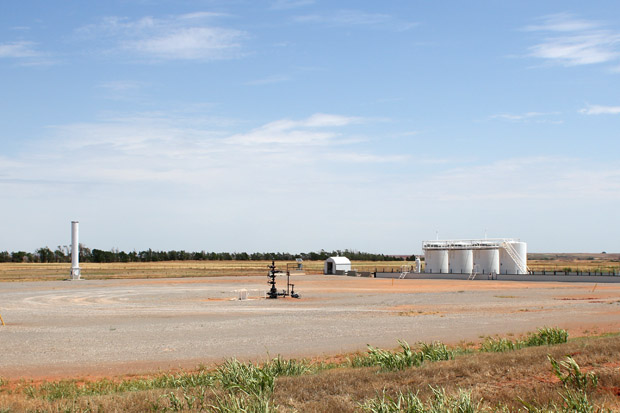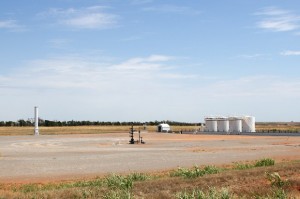
A waste fluid disposal well in western Oklahoma.
Joe Wertz / StateImpact Oklahoma


A waste fluid disposal well in western Oklahoma.
Joe Wertz / StateImpact Oklahoma

Joe Wertz / StateImpact Oklahoma
A waste fluid disposal well in western Oklahoma.
Central Oklahoma is still experiencing a “significant rise” in magnitude 3.0 or greater earthquakes, and federal and state seismologists are collaborating to study possible links to disposal wells used by the oil and gas industry, the U.S. Geological Survey says.
From 1975-2008, central Oklahoma averaged between one to three 3.0-magnitude quakes a year. That annual average grew to about 40 per year from 2009 to mid-2013, federal seismologist Bill Leith wrote on the USGS website. As a result, the USGS has raised central Oklahoma’s earthquake “hazard” risk to account for more frequent and more damaging earthquakes, a move that is forcing municipalities to reconsider building codes.
Since 2009, central Oklahoma has experienced more than 200 magnitude 3.0 or greater earthquakes, Leith writes. This swarm includes Oklahoma’s largest earthquake on record, the 5.7-magnitude quake that shook near Prague in November 2011, injured two people and damaged more than a dozen homes. Other researchers had already concluded the Prague quake was likely triggered by disposal wells.
Oklahoma is seismically active, but many recent quakes don’t appear to be naturally occurring, Leith writes:
“We’ve statistically analyzed the recent earthquake rate changes and found that they do not seem to be due to typical, random fluctuations in natural seismicity rates,” Leith writes.
The analysis suggests that a contributing factor to the increase in earthquakes triggers may be from activities such as wastewater disposal–a phenomenon known as injection-induced seismicity. The OGS has examined the behavior of the seismicity through the state assessing the optimal fault orientations and stresses within the region of increased seismicity, particularly the unique behavior of the Jones swarm just east of Oklahoma City. The USGS and OGS are now focusing on determining whether evidence exists for such triggering, which is widely viewed as being demonstrated in recent years in Arkansas, Ohio and Colorado.
Disposal wells are commonplace in Oklahoma and other oil and gas states. Oil and gas operators use disposal wells to store brine and other toxic drilling fluids deep underground, where they won’t contaminate water supplies. Oklahoma has thousands of disposal wells.
Earthquakes in a half-dozen other states, including Arkansas, Colorado, Ohio and Texas, have been cited as being possibly triggered by disposal wells. Oil and gas regulators in Oklahoma and Texas have been more passive than other states in writing rules to minimize the risk, a StateImpact analysis shows.
In September, the Oklahoma Corporation Commission ordered a disposal well operator in south-central Oklahoma to reduce the pressure and volume of waste fluid injection after a swarm of earthquakes struck near Marietta in Love County.
The Oklahoma Geological Survey has installed portable seismic monitors to study the central Oklahoma and Love County quakes.